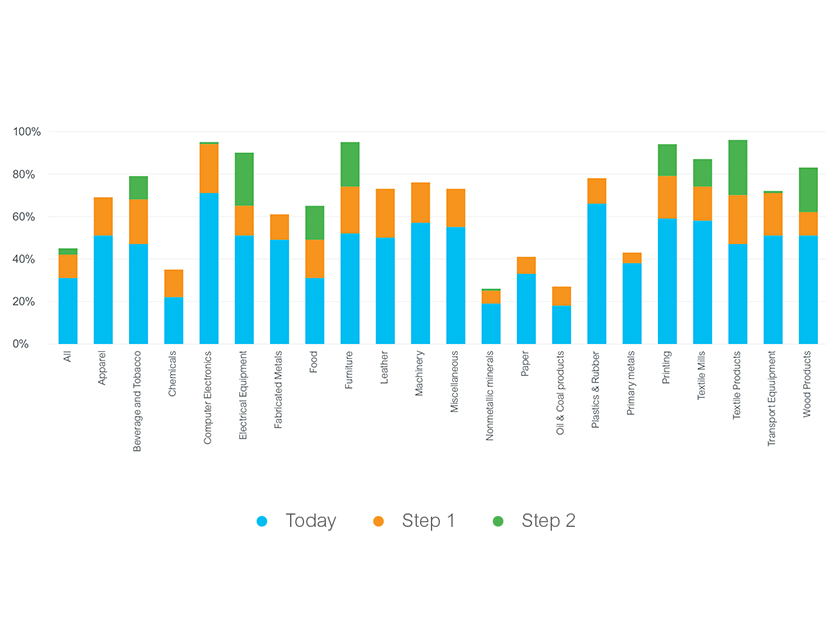
The U.S. could ramp up the electrification of heavy industry by 50%, reduce the sector’s fossil fuel use by 25% and cut its greenhouse gas emissions by 100 million metric tons per year by 2030, according to a new report from Schneider Electric’s Sustainability Research Institute.
But hitting those ambitious targets will require a shift of focus, the report says. Instead of prioritizing long-term solutions for the hardest-to-abate industries, such as petrochemicals, oil and coal, a different approach could zero in on the lower-hanging fruit of individual processes that can be electrified with existing technologies and without major changes to production.
“Emissions are not all equal,” the report says. “Those that can be reduced more rapidly hold much greater value than those that could be reduced in the future (even if massive).”
Pushing toward President Joe Biden’s goal of reducing the nation’s GHG emissions by 50 to 52% from 2005 levels by 2030, the U.S. has focused on electrification of transportation and buildings via incentives in the Inflation Reduction Act. But industrial electrification varies from sector to sector, the report says.
Electric arc furnaces are widely used in steel production, but options for electrifying the high-temperature process heat needed for chemicals and oil and gas refining still are in the demonstration phase, according to the Department of Energy’s recent Pathways to Commercial Liftoff: Industrial Decarbonization report.
Industry accounts for about 23% of U.S. greenhouse gas emissions, according to EPA. The Schneider report notes that five sectors ― chemicals, petroleum and coal products, primary metals, nonmetallic minerals and paper ― make up close to 75% of that total.
Traditional approaches to industrial decarbonization require that certain hard-to-abate industries continue to rely on natural gas or other fossil fuels to produce the high heat they need, until alternative technologies such as green hydrogen, carbon capture and sequestration, and small modular reactors can be commercialized at scale.
The report cites 2020 research from the California Energy Commission suggesting that building electrification could drive a switch away from natural gas and a decrease in the customer base, driving up natural gas prices for buildings and industry. Natural gas prices for industry could double by 2030, the CEC report predicts.
“This is particularly relevant in the context of rapid relocalization of a number of industries in the country,” the Schneider report says. “Will these new facilities be built for a net-zero world, relying on alternative and sustainable energy resources, or will they be connected to the existing natural gas grid and perpetuate reliance on fossil fuels?”
To move toward electrification, the report breaks down industrial energy use and emissions into subprocesses ― direct and indirect, process and nonprocess ― and identifies which could be electrified quickly in the coming decade. For example, most nonprocess energy use ― that is, energy not used for manufacturing but for building operations such as lighting and space heating and cooling ― could be rapidly electrified with existing technologies.
A second phase of industrial electrification would include the technologies currently being demonstrated but not yet deployed at commercial scale, especially for targeted processes in sectors such as food and beverage, textiles and electrical equipment, the report says.
Of the 21 industrial sectors analyzed in the report, the combination of the first and second phases could push eight to 80% electrification and 16 to at least 60% within a decade.
The report notes that half the reductions in fossil fuel use and GHG emissions will come from “easy to abate” industrial sectors, rather than hard-to-abate processes.
The report acknowledges the reduction in fossil fuel use will increase electricity demand ― by about 300 TWh per year ― but assumes that this new demand would be met with the wind, solar and storage sitting in interconnection queues across the country, providing additional efficiencies and emission reductions.
Getting the Finances Right
Beyond 2030, a third phase of industrial electrification would require innovative technologies still in development, such as electric “cracking” furnaces used in the production of petrochemicals and other electric furnaces, the report says.
Such innovations could drive industrial electrification to 64% across sectors, with 14 sectors hitting 80%, the report says.
“This major opportunity challenges the current hard-to-abate-centric approach to industrial decarbonization, which suggests little is achievable until new innovations deploy at scale.”
The obstacles ahead include a lack of information about the potential benefits of industrial electrification, getting the finances right and “grid reinforcements, which take several years to materialize.” The report provides general, mostly familiar recommendations.
To raise public and industry awareness, the report proposes the launch of dedicated state offices or clearinghouses to advance industrial electrification.
Getting the finances right will require making the cost of electrification competitive or at least comparable with natural gas, through tax incentives but also new approaches to electricity rate-setting, including time-of-use rates, to promote system flexibility.
Grid modernization and expansion will take time and will “come at the expense of natural gas grids and their associated revenues,” the report says. “This also requires a specific policy focus to ensure a smooth transition.”
